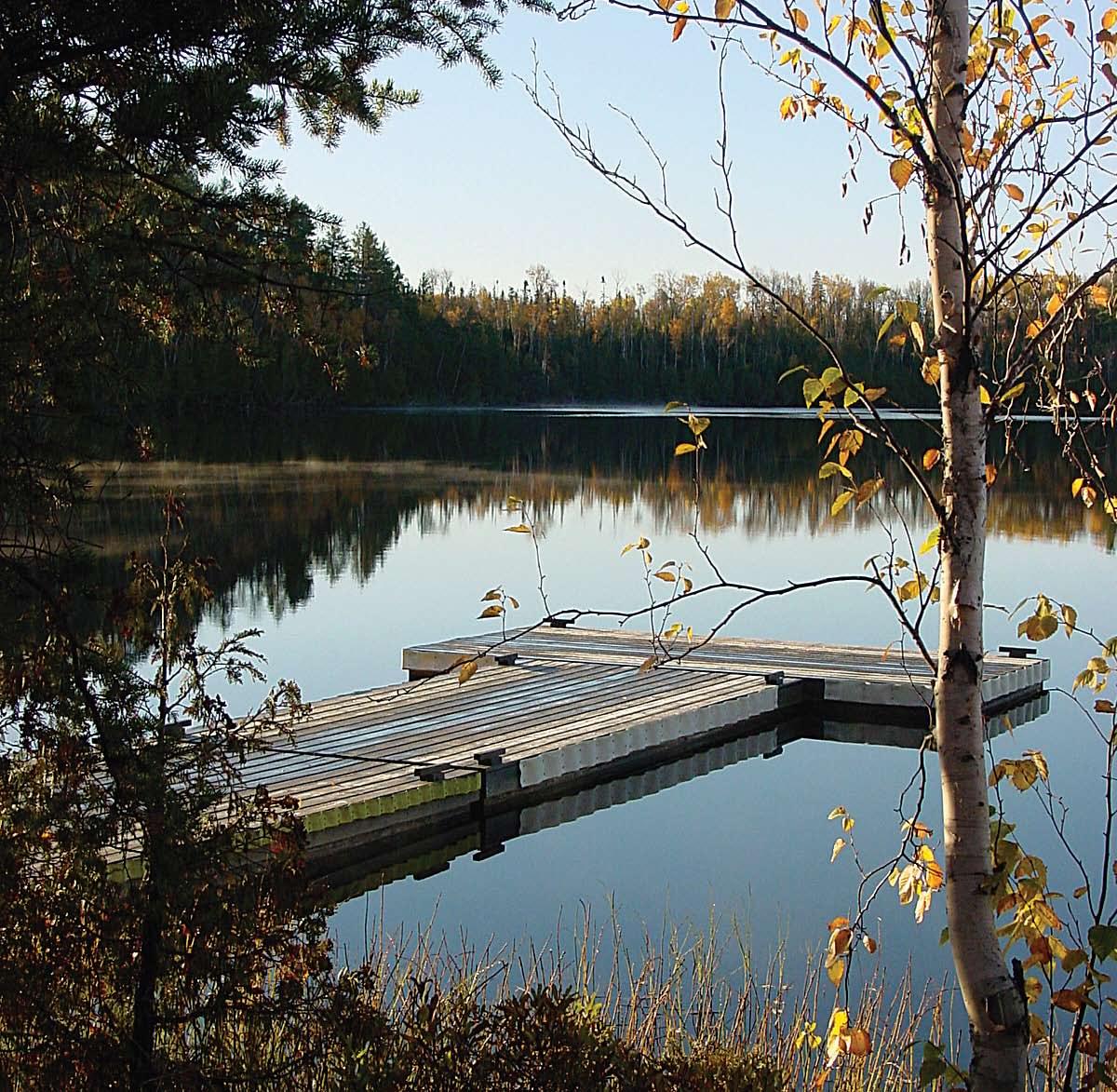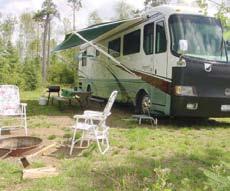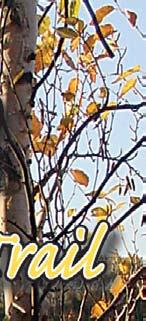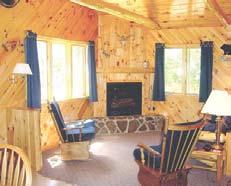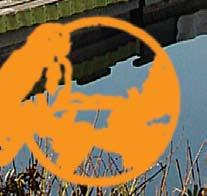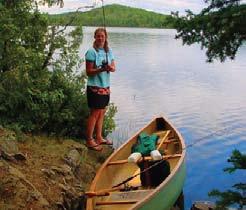

















Epic Singletrack

















Dulu Fresh & Local Food Guide
Duluth’s Epic Singletrack • Fresh & Local Food Guide • Powwow 101 • Isle Royale Invasion
Isle Royale Invasion











































Epic Singletrack

















Dulu Fresh & Local Food Guide
Duluth’s Epic Singletrack • Fresh & Local Food Guide • Powwow 101 • Isle Royale Invasion
Isle Royale Invasion
























Summer on Minnesota’s North Shore is best described as “unusual” this year. Beginning July 1, the state government shut down because the Governor and Legislature could not agree on a budget. Our state parks and waysides were closed and barricaded, anglers weren’t been able to buy fishing licenses and highway construction was halted. Here at Northern Wilds, about all we can say to our readers is, “Sorry for the inconvenience” and “Don’t blame us.”
We hope the State of Minnesota will be open by the time you read this. But regardless of the shutdown, you can fi nd fun in Minnesota and Ontario. In fact, we’ve even heard some intrepid travelers crossed the border into Ontario because the parks and campgrounds are open. If you join them, be sure to read Elle Andra-Warner’s story about exploring the backroads of Thunder Bay, including Chippewa Park’s wooden horse carousel. Hiking, biking and paddling trails are open everywhere. Eric Chandler provides a roundup of North Shore trails suitable for hiking with kids and, in another story, gives us the lowdown on Duluth’s network of singletrack mountain bike trails. Lucas Will, who has paddled around Lake Superior, tells us about his favorite spots along the way. Kate Watson met a group of women whose Boundary Waters adventures proudly include an evening cocktail hour.

August is also when the North Shore’s native people gather for powwows at Grand Portage and Old Fort William. Anna Martineau-Merritt explains how you can participate in a powwow and experience native culture. Kevin Bovee learned about our logging heritage and had a great lunch at the historic Tom’s Logging Camp. Shelby Gonzalez learned about natural dyes at the North House Folk School in Grand Marais. Be sure to check out her fall color safari, too. Out in the woods, Gord Ellis takes us bear hunting without using bait to attract the bruins. Mike Furtman explains why blue birds aren’t really blue. Gardener Joan Farnam talks about harvestin g your backyard bounty and what to do with it when you do. If you don’t garden, Joan also has an excellent roundup of farmer’s markets and other places where you can purchase locally grown produce. In fact, you could say this issue of Northern Wilds is good enough to eat.
–Shawn Perich and Amber Pratt
about in the Northern Wilds. Send to editor@northernwilds.com.





























































Got trails? In late June, Boy Scouts and adult Scouters from the Boy Scouts of America’s honor society—called the Order of the Arrow—traveled to Grand Marais to build new trails and improve existing ones in different areas of the North Shore. Eight separate crews constructed new mountain biking trails at Pincushion Mountain near Grand Marais and Sugarbush near Tofte, and improved sections of the Superior Hiking Trail. The effort, a partnership with the Forest Service, was called “ArrowPower 2011: Service on the Superior.”
The Superior Hiking Trail Association, Superior Cycling Association, Conservation Corps of Minnesota and Iowa, and International Mountain Biking Association provided additional support and coordination. Scouts and leaders were based at Cook County High School and spent 8 hours a day out working on the trails. In the evenings, they toured the area and participated in educational and recreational events at the high school. For more information about the Boy Scouts, see w ww.scouting.org. For more information about the Superior National Forest, see: w ww.fs.usda.gov/superior.
This one’s for the birds. Improved conditions in much of the waterfowl breeding habitat in Canada and the prairies of the north-central United States have contributed to higher populations of many species of ducks, including a record abundance of blue-winged teal, according to breeding population estimates released by the US Fish and Wildlife Service.
The preliminary estimate of the total duck population from the traditional survey area (north-central United States, south-central and northern Canada, and Alaska) was 45.6 million birds. This estimate represents an 11 percent increase over last year’s estimate of 40.8 million birds and is 35 percent above the long-term average.

Managing editor Shelby Gonzalez strikes a pose after her successful ascent of Wiese’s Spire, an obscure backcountry climb near Ely’s Peak. |
CORA MCGLAUFLIN
Other highlights include:
Estimated mallard abundance was • 9.2 million birds, a 9 percent increase from the 2010 estimate.
Blue-winged teal estimated popula- • tion was a record 8.9 million, which was 41 percent above the 2010 estimate of 6.3 million, and 91 percent above the long-term average.
The northern pintail estimate of • 4.4 million was 26 percent above the 2010 estimate of 3.5 million. Estimated abundance of American wigeon was 14 percent below the 2010 estimate and 20 percent below the long-term average.
Most recreational boats in the US are “trailer” boats. Stored in the backyard or driveway, they are trailered to the water and enjoyed for the day. They are also refueled at your local gas station or minimart, which may soon offer a fuel, E15 (or 15 percent ethanol), that is prohibited by the federal government for use in boat motors and violates engine manufacturer warranties. That has the nation’s largest recreational boat owners group, BoatUS, concerned over the potential for accidental misfueling.

Uh,
| BOATUS
“As this new fuel starts appearing at the local fuel pump, we see the real likelihood of putting the wrong fuel in your boat,” said Margaret Podlich, BoatUS vice president of government affairs. “It could lead to costly engine or fuel system damage, and potentially leave you stranded out on the water with a disabled vessel, compromising your family’s safety.
When a boat’s engine stops running, you can’t pull over to the side of the road.”
Earlier this year, the EPA authorized the use of E15 in 2001 model year and newer motor vehicles. However, the agency did not authorize its use in marine engines or off-road vehicles, tools and equipment.
“I encourage anyone fueling – whether it’s for your boat, car, motorcycle, generator or six-gallon portable tank for your lawnmower or leaf-blower, to absolutely know what type of gas is going into that tank,” she said.


While snow may not be on your mind just yet as you savor the last of summer and the brightness of autumn, it’s never too early to get psyched for winter. You can’t beat the Northern Wilds for a wintertime getaway. For a full list of events, visit www.northernwilds.com
Craving nature and peace? Snowshoe by candlelight, ski on the continent’s largest groomed cross-country ski trail system, drill an ice-fishing hole, or simply snuggle up to a crackling fireplace.
Longing for family togetherness? Go ice skating, take a sleigh ride, or board the Polar Express.
Prefer a steady stream of adrenaline to keep you warm? Ski or snowboard for a fraction of the cost of an out-West vacation, try ice climbing or snowkiting, or put Fido to work with skijoring or dogsledding excursions.
Midwest Mountaineering
Outdoor Adventure Expo
Minneapolis • Nov. 18-20 www.outdooradventureexpo.com
Winterers Gathering X and Arctic Film Festival
North House Folk School
Grand Marais • Nov. 17-20 www.northhouse.org
Bentleyville “Tour of Lights” Duluth • Nov. 19-Dec. 26 www.bentleyvilleusa.org
AMSOIL Duluth National SnoCross Spirit Mountain, Duluth • Nov. 25-27 www.visitduluth.com
Volks Ski 400 Cook County • Date TBA www.volksski.com
John Beargrease Sled Dog Marathon Duluth-Grand Marais • Date TBA www.beargrease.com
Ely Winter Festival Ely • Feb. 2-12 www.elywinterfestival.com
Winter Plein Air Painting Festival
Gunflint Trail • Date TBA www.grandmaraisartcolony.org
Snow Kiting Expo
Duluth • Date TBA www.d.umn.edu
Lutsen Mountains Family Festival Lutsen Mountains • Date TBA www.lutsen.com
Two Harbors Winter Frolic
Two Harbors • Feb. 10-11 www.twoharborswinterfrolic.com
Mukluk Ball Benefit
Fortune Bay Resort Casino, Ely • Date TBA www.fortunebay.com
Warmer By the Lake Festival Bayfront Festival Park, Duluth • TBD www.visitduluth.com
Mush for Kids Duluth • Date TBA www.outdooredventures.org
Voyageur Winter Carnival
Fort William Historical Park
Thunder Bay • Date TBA www.fwhp.ca
Mountain Mardi Gras Spirit Mountain, Duluth • Date TBA www.spiritmt.com
Central Canada Outdoor Show
Thunder Bay • Feb. 24-26 www.tb-chamber.on.ca
Winter Tracks Festival North


Minnesota’s forestry-related business sectors contribute $17.1 billion annually to the state’s economy and provide 86,775 jobs, according to a new DNR report. Minnesota’s native forests, plantation forests, community forests and urban trees not only help maintain a healthy environment, provide clean water and enhance our quality of life, they are also a cornerstone of the state’s economy.
About 40 percent of the forest products manufactured in Minnesota are used locally; the rest are shipped to other states and countries. Minnesota annually exports $707 million worth of pulp, paper and paperboard prod-
ucts to other countries, with China and Canada as the biggest customers. Minnesota’s forest landowners annually receive about $80 million in timber revenue. Timber harvested from DNR-administered land generates $1.3 billion industry output on a yearly basis and supports 5,050 jobs through primary forest products manufacturing.
The report is a collaborative effort between the University of MinnesotaDuluth’s Bureau of Business and Economic Research and the DNR Division of Forestry. More information at www.dnr.state.mn.us/forestry/ um/index.html.


If you’ve ever dreamed of celebrating the beauty of the Great Lakes and having your creativity immortalized on a beer coaster (who hasn’t?), here’s your chance. Biodiversity Project’s Great Lakes Forever program has again partnered with Budweiser to sponsor the 7th annual photography and art contest that celebrates the beauty of the Great Lakes through the talent of local photographers and artists. Great Lakes Forever is a nonprofit
education and activism campaign designed to raise awareness about the vulnerability and value of the Great Lakes. The grand prize winner in both the photography and art categories will be featured on the 2011 Great Lakes Forever/Budweiser beer coasters. These coasters will be distributed to bars and restaurants throughout the Great Lakes region. Over 120,000 coasters were distributed last year. In addition to being featured on
the 2011 beer coasters, the top three vote-getters in each category will also receive Budweiser prizes. The entry deadline is Aug. 14. See www.greatlakesforever.org for contest rules and submission details.


Until recently, hikers wanting to scale Eagle Mountain to reach Minnesota’s highest point have had to rely on two canoeing maps.
“Each spring I would take the two maps covering the trails and cut away two-thirds of it with a scissors,” says Martin Kubik, founder and president of the Boundary Waters Advisory (BWA) Committee. “I then would tape the remaining pieces together to make it easier to take in and out of my pocket.”
Such a crafts project is no longer necessary. The BWA Committee and McKenzie Products have unveiled a new hiking map for the Eagle Mountain Trail in the Boundary Waters Canoe Area and Brule Lake Trail. Measuring 12 by 15 inches, it retains the map scale that BWCAW canoists are familiar with. It is printed on a waterproof, tear-resistant synthetic paper. The map includes a new campsite on Fishook Lake, the result of a two-year collaborative effort between the Forest Service and the BWA Committee.

The “Eagle Mountain/Brule Lake Map” can be purchased from McKenzie Products, info@ bwcamaps.com, or by calling 1-800-749-2113. The map is also available at the Lake Superior Trading Post in Grand Marais. For more information about volunteer trail clearing trips, visit www.bwac.smugmug.com or contact Martin Kubik at bwca.trails@yahoo.com.
In last issue’s map feature, “Rockhound Road Trip,” we left out the captions for the photos on pages 15-16. Our apologies for any confusion. The correct captions and credits are below.
PAGE 15: Collecting rocks on the Lake Superior shoreline can be a solitary or group pursuit. | JAMES SMEDLEY
Amethyst is the birthstone for people born in February. | SIMON BLACKLEY/ FLICKR
Thomsonite is sometimes found still embedded in basalt. The waviness of the stromatolite columns in Mary Ellen jasper may stem from the ancient cyanobacteria “tracking” the sun. | JAMES ST. JOHN, OHIO STATE
A clump of fossils embedded in matrix, or surrounding material, is called a concretion. | SANKAX/FLICKR
PAGE 16: This Lake Superior agate exhibits a “fortification” pattern on one face. | SHELBY GONZALEZ
Transparent beach glass is very common. | CLAIRITY/FLICKR
GRAND MARAIS SEPT. 10-11
Sashay over to Sweetheart’s Bluff in the Grand Marais Recreation Area and lend your ears to the fourth annual Radio Waves Music Festival, put on by local radio station W TIP. Groove to the sounds of talented local musicians and enjoy food vendors and a children’s activity area. Details at www. w tip.org.
GRAND MARAIS SEPT. 15-18
The tenth anniversary of Unplugged, presented by North House Folk School, w ill include two shows with the NPR radio program Mountain Stage, the classic Saturday night concert, speakers, mini courses and traditional craft workshops. See www.northhouse.org/programs/ events/unplugged.htm.
Sawtooth
GRAND MARAIS AUG. 27
Climb from downtown Grand Marais to the slopes of Pincushion Mountain –and down again – as part of this something-for-everyone event. Race distances range from 8-24 miles and include beginner, sport and expert-level races. Details at www.sawtoothchallenge.org.
DULUTH SEPT. 17
Take on the same course as Grandma’s Marathon runners, but with wheels instead of treads. The 16th annual NorthShore Inline Marathon event includes a half marathon, a full marathon, a pre-race spaghetti feed, and a skate and fitness expo. Details at www. northshoreinline.com.
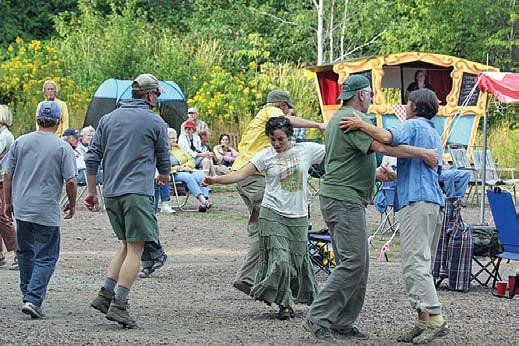
HAWK RIDGE BIRD
DULUTH SEPT. 16-18
Whether you are an obsessive birdwatcher or a casual bird-spotter, you are sure to get a thrill from seeing hundreds or even thousands of migrating hawks hugging the North Shore on their long annual journey. Join the Hawk Ridge celebration and viewing of this event during what could be a peak color weekend. More information at www.hawkridge.org.
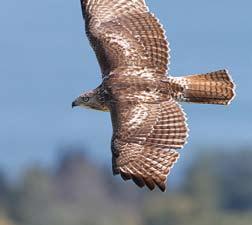
NIPIGON SEPT. 24
By Tasha Sutton
Every year, on the last Saturday of September, the Land of the Nipigon Waterways and the Rotary Club of Nipigon host a “Hike for Health” alon g the Nipigon River Recreation Trail in order to raise monies for the area. Durin g the rugged 10 km trek, hikers enjoy views from three lookouts over Nipigon Bay on Lake Superior, and later relax on the leisurely portion of the trail beside the Nipigon River and its wetlands.
The day begins with a bus ride from the Nipigon Trailhead to Red Rock, where hikers are greeted with a complimentar y continental breakfast at the Red Rock Fish and Game Club. Water stations are available along the hike, and the hike wraps up with a lunch, entertainment and prizes at the Nipigon Community Centre. Pledge sheets are available throughout the district and at the breakfast in Red Rock. This is a family affair; hikers from as young as three to over eighty have participated.Details at www.nipigon.net/visitors.














AUG 1



Grand Portage National Monument
Interpretive Programs daily till Sept 5. 218-475-0123
AUG 2
Daniel Tosh - Tour on Ice Thunder Bay Community Theater 7:00 p.m. 8 07- 343-2310
Superior Dream
Kayaking the World’s Largest Lake Lutsen Resort 7:30 – 9 p.m. info@lutsenresort.com
Hedstrom’s Mill Guided Tour
Gunflint Trail 12:30 p.m. – 1:30 p.m. Res. required 218-387-2995, ext 11
Naturalist Program
Wildlife Found in Minnesota Woods and Lakes Grand Marais RV Park 7:30 p.m. – 9 p.m.
Naturalist Program
Loons of Minnesota Northern Lakes Bluefin Bay Resort- Tofte 7:30 p.m. – 9 p.m.
AUG 37
Fisherman’s Picnic Tennis Tournament www.cookcountytennis.org
AUG 47
Fisherman’s Picnic Grand Marais www.gmlions.com
AUG 4
Small Talk with Dale Tormondsen on Commercial Fishing Lake Superior. Cook County Museum, Grand Marais 4 p.m. 218-387-2883
AUG 4,6,12 AND 14
Shout! A Musical Arrowhead Center for the Art, Grand Marais 7 p.m. Sunday at 2 p.m. 218-387-1284
AUG 57
Live from the Rock Folk Festival
Red Rock, Ontario Livefromtherock.com
Two Harbors
Kayak Festival Stand-up Paddle Race on Sunday. Two Harbors kayakfestival.org
AUG 5, 7, 11, 13
Always Patsy Cline Arrowhead Center for the Art, Grand Marais 7 p.m. Sun at 2 p.m. 218-387-1284
AUG 6
Nature Talk - What’s Up with North Shore Moose? Sugarloaf Cove, Schroeder10 a.m. www. sugarloafnorthshore.org
AUG 12
Free Community Dance North Shore Swing Dance Band. 4H Building, Grand Marais 7-9 p.m. 218-387-2358
Relay for Life
National Walk Sponsored by American Cancer Society Silver Bay 218-226-4576
AUG 1214
Rendezvous Days – Pow
Wow Grand Portage Heritage Center and Historic Site 218-475-0123 ext 255
Anishnawbee Keeshigun
Native Festival
Fort William Historical Park, Thunder Bay events@fwhp.ca
23rd Bayfront Blues Festival Duluth www.bayfrontblues.com
AUG 1228
Alice Powell
“A Superior Life –50 plus years on the North Shore” Johnson Heritage Post Grand Marais 218-387-2314
AUG 13
Nature Talk
Ice Cream, Spiders and Fun Featuring Larry Weber Sugarloaf Cove, Schroeder 1 p.m. www.sugarloafnorthshore.org
AUG 13 14
Tori Celebration and Fall Music Festival Finland
AUG 19
Leo Kottke in Concert Arrowhead Center for the Art, Grand Marais 7:30 p.m. www.northshoremusicassociation.com
AUG 1920
Cook County Fair Cook County Community Center, Grand Marais 8 a.m. – 6 p.m. www.ccfair.weebly.com
AUG 20
Gitchi Gami Bike Ride
Gooseberry State Park to Beaver Bay www.ggta.org
Nature Photography with Barry Wojciechowski
Sleeping Giant Provincial Park, Ontario 10 – 5 p.m. www.superiorvisits.com
Field and Screen Tips and Techniques for Outdoor Photography Sugarloaf Cove, Schroeder 10 a.m. www.sugarloafnorthshore.org
AUG 2021
Bayfront Park Art Fair
Duluth 10 a.m. – 6
Artinbayfrontpark,com
AUG 26 SEPT 4
9th Annual Plein Air
Painting Competition art@boreal.org
AUG 25 SEPT 4
Gas and Candles
Arrowhead Center for the Arts, Grand Marais 7 p.m. Sun: 2 p.m. 218-387-1284
AUG 27
Guided Hike
Cascade State Park to Caribou Trail 10 a.m. www.shta.org
AUG 27
Sawtooth Mountain Bike Challenge
15 South Broadway 10 a.m. Bike@boreal.org
Nature Talk
Lake Superior Invasive Species Sugarloaf Cove, Schroeder 10 a.m. sugarloafnorthshore.org
SEPT 1 25
Plein Air Curated by the Art Colony Johnson Heritage Post, Grand Marais
SEPT 4
A Taste of the Gunflint Chik-Wauk Museum and Nature Center and Gunflint Trail businesses1 p.m. – 5 p.m. www.gunflint-trail.com
SEPT 9 10
Fall Superior Trail Race www.superiortrailrace.com
SEPT 10
Fort William
Fall Street Festival 10:30 a.m. – 4:30 p.m. Thunder Bay info@victoriabia.ca Riverfest
Kam River Heritage Park, Thunder Bay Noon – 5 p.m. 807-625-2487
SEPT 1011
WTIP Radio Waves Music Festival wtip.org
SEPT 1518
Unplugged X with Mountain Stage North House Folk School Info@northhouse.org
SEPT 17
Finn Fest & Booya. Finland Rec. Center. Fall Color Tours into October. Finland MN 10 a.m. – 4 p.m. FinlandHOA@yahoo.com
Guided Hike
Temperance River Wayside to Cook Co Rd 1.10 a.m. www.shta.org
SEPT 1617
North Star Expo
Logging/Trucking/Sawmill Show Grand Rapids 218-722-5013
SEPT 1618
Hawk Weekend
Hawk Ridge Nature Reserve, Duluth www.hawkridge.org
SEPT 17
North Shore Inline
Marathon Two Harbors to Duluth northshoreinline.com
SEPT 18
Terry Fox 5 K Run/Walk Thunder Bay 2 p.m. 807-623-8338
Thunder Bay Marathon –Miles with the Giant 8 a.m. 2 p.m. Marina Park, Thunder Bay 807-627-7770
SEPT 22
Wine and
Beer Tasting Gala
Cross River Heritage Center, Schroeder 7:00 pm 2 18-663-7706
Bachman and Turner Thunder Bay Auditorium
8 p.m. 800-463-8817
SEPT 23 OCT 2
Art Colony Annual Member Show Grand Marais Art Colony www.grandmaraisart colony.org
SEPT 24
Guided Hike
Temperance River Wayside to Britton Peak 10 a.m. www.shta.org
SEPT 28 OCT 7
Crossing Borders Artists’ studios along Highway 61 crossingbordersstudiotour.com
SEPT 29
Red Green Tour Thunder Bay Auditorium 8 p.m. 800-463-8817
SEPT 29 OCT 2
Bay Street Film Festival Finlandia Club, Thunder Bay www.baystreetfilmfestival.com
SEPT 29 OCT 16
Wings, Water and Wildflowers
Johnson Heritage Post, Grand Marais 218-387-2314
SEPT 30
Fall Colors Workshop
Photography with Barry Wojciechowski. Sleeping Giant Provincial Park, Thunder Bay 10–5 p.m. superiorvisits.com
OCT 1
Guided Hike
Caribou River Wayside to Cook Cty. Rd 1 10 a.m. www.shta.org

By Anna Martineau-Merritt
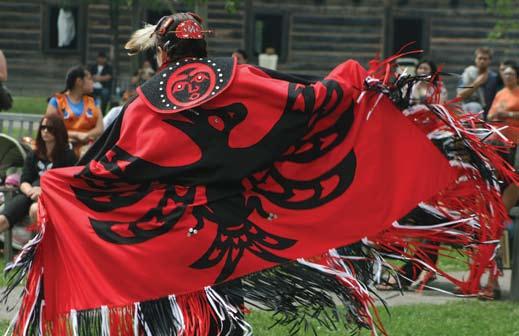
If you have never been to a historical reenactment or powwow, here are a few things to know. You are encouraged to watch and participate in both events. Know your terminology. The elaborate, colorful outfits worn at the powwow are not “costumes,” explains Dana Logan, Grand Portage powwow chair. The outfits are called regalia, and each piece and part has a meaning and a story.
Taking broad “scene” photos is fi ne at the group events. If you want to snap a photo of an individual actor at Rendezvous dressed
in period clothing or a person at the powwow dressed in traditional regalia, be respectful and ask permission fi rst. At certain times, cameras are not allowed. Some dances are reserved for tribal members.
The emcee will set out rules, announce intertribal dance times when everyone is welcome to dance, and explain the signifcance behind individual dances. The emcee will also be happy to answer your questions. Details at www.grandportage.com.
Aug. 12-14 • Grand Portage National Monument
You won’t see buckskin suits and Daniel Boone hats at Rendezvous, explains Pam Neil, event coordinator for the event. This reenactment, which has taken place since the early 1970s, is set in the Great Lakes time period, from the late 1780s to the early 1800s. Rendezvous gives history-lovers a chance to brings to life the annual gatherings where voyageurs and Native people would come together to trade goods and sell furs to the North West Company. Details at www.nps.gov/grpo.

Anishnawbe Keeshigun Aboriginal Festival
Aug. 19-21 • Fort William Historical Park, Thunder Bay
Fort William historical park has been hosting the Anishnawbe Keeshigun Aboriginal Festival for nearly 25 years. Marty Mascarin, communications officer at the park, explains the festival’s name. Anishnawbe means”original people” –this is the word that the Aboriginal people use to refer to themselves – and keeshigun means to “day” or “days.”
Friday evening’s festivities focus on Aboriginal art. Saturday and Sunday are full of powwow dancing, drumming, vendors, hearty food and people dressed in colorful regalia in the dance arena. Everyone is encouraged to take part in the festivities. As with other powwows, listen to the emcee for directions and information. Details at www.fwhp.ca.

The Grand Portage Reservation sponsors a powwow near Rendezvous each year. Powwows were held to celebrate the end of a long winter, the return of hunters, a good harvest, and even new romances. The powwow will include Native vendors selling all kinds of crafts and abundant food, such as wild rice soup, burgers, hot dogs, and almost anything you can do with fry bread – including fry bread tacos. Due to the decline in the moose population, the Tribe has decided to take moose off the menu.
reservations call: 1-800-543-1384 or visit: www.grandportage.com

Six top Superior Hiking Trail treks, plus the secret of “lollipop power”
Story and photos by Eric Chandler
Here’s the most important tip for hiking w ith kids: leave them wanting more. Kids can go farther than you think, but you have to keep them interested or a fun family hike can turn into a miserable slog. Luckily, the North Shore has day trips with attention-getting views and lots of “wow” per mile. So grab your kids and head for the hills.
Afterward, make sure “hiking” equals “fun.” Stop at the local ice cream or pie establishment for a reward. You—oops, they deserve it.
If you’re talking about walking in the Northern Wilds, you’ll eventually mention the Superior Hiking Trail (SHT). The queen of North Shore hiking is 275 miles long, with a 39-mile section right through Duluth. The SHT is full of day trips that are just right for families. Here are six of them. Details at w ww.shta.org.
This gem of a trip starts at the Munger Trail trailhead at 123rd Avenue West off

Beck’s Road. This 1.8-mile round trip starts down the paved Munger Trail. Very quickly, you start up open ledges with fantastic views of the St. Louis River. Find the 300-foot spur to the summit and tuck into a picnic lunch.
This stand-alone system is connected to the SHT by a spur. Find the easternmost section of Skyline in Duluth and drive east until you see an informational kiosk. There are several trail options from here that have great views of Gitchee Gumee and, if you’re lucky, thousands of migrating raptors. Visit www.hawkridge.org to learn more about the trails and Hawk Weekend on Sept. 16-18.


Find your way to the trailhead on the north side of Penn Boulevard outside of Silver Bay. This 5-mile round trip was somewhat challenging, but we got through it by employing another classic tactic for hiking with kids: Lollipop Power. The massive cliffs and incredible views of Bean Lake made the bribery totally worth it.
What kid doesn’t like to walk on a footbridge over a river? And then see the highest waterfall within the borders of Minnesota? At Tettegouche State Park, drive uphill to the highest parking lot and begin the 1-mile round trip to see if your kids are immune from the charms of rushing water.

I asked Andy Holak for some family trail suggestions. He owns the Adventure Running Company (www.adventurerunningco.com) based in Duluth with his wife Kim. They’ve been running on the SHT for 15 years. He said Carlton Peak is a great hike for kids. He has a picture of his children at the summit when they were “really little.” Go 2 miles above Tofte on the Sawbill Trail to get to the trailhead.
I’ll admit it. This is my favorite. It’s just right: awesome views of Lake Superior, eas y to get to, plenty of cliffs to take your breath away, and in the fall the colors are dazzling. Find the Onion River Road (Forest Road 336) and go uphill to the trailhead parking lot. You can thank me later.










Story
and photos
Driving up Hwy. 61 and spotting the iconic white draft horses hooked to a loaded timber sled, you may guess that Tom’s Logging Camp is a place to stop and get a history fi x. What you might not guess is that it’s also a place to get a food fi x.
First, the history. Tom’s Logging Camp and Old Northwest Company Trading Post recreates a northern Minnesota logging camp from days gone by. The main v isitor trail winds through thick spruce and pine woods to a series of authentic-tothe-period buildings, among them a horse barn, a bunkhouse, a blacksmith shop, a cook shack, and, of course, a Finnish sauna. Each building boasts historically accurate tools and decor.
Interspersed along the trail is a trout pond and pens with pygmy goats and llamas. The trading post features local staples like wild rice, maple syrup, jams and jellies, handmade soaps and Minnetonka moccasins.
Tom’s Logging Camp is run by Lauren and Bill Weckman and assisted by their twin daughters. The original owner, Tom Deebach, settled the business at its current location around 1960. Lauren is the daughter of the second owner and has been running the operation for almost 25 years.
In 2010, the Weckmans added food to the mix. Sandwiches, soup, beverages and ice cream can be purchased at the café. Sit down inside the café or outside at a picnic
by Kevin J. Bovee

table, or get it to go if you’re in a hurry. The food is prepared on-site, using local goods whenever possible. For example, the bread is crafted at an artisanal bakery in Superior, Wis. and the wild rice hails from Grand Rapids.
Bill runs the food side and has two madefrom-scratch soups each day along with sandwiches and sides like cole slaw and potato salad. Try the soup and sandwich special if you can’t decide what to get.
My wife Mary and I recently stopped at Tom’s Logging Camp for a lunch date. She got the corn chowder and a turkey sandwich on cranberry-wild rice bread, while I sampled the cream of wild rice soup and a beef sandwich. The cream of wild rice is the bestselling soup. Its tastiness is unsurprising, given that the recipe calls for a quart of cream.


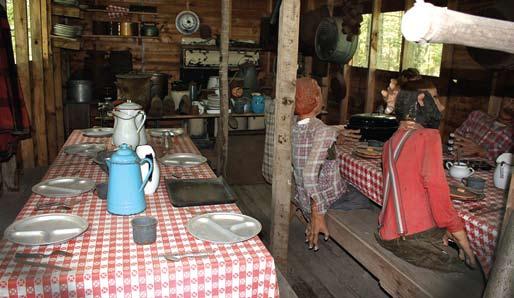
Visitor Information: Tom’s Logging Camp and Old Northwest Company Trading Post is located about 16 miles northeast of Duluth off of Hwy. 61. Open May 1 through Oct. 20 each year. Summer museum hours are 9 a.m to 7 p.m., seven days a week. More information at (218) 525-4120 or www.tomsloggingcamp.com.

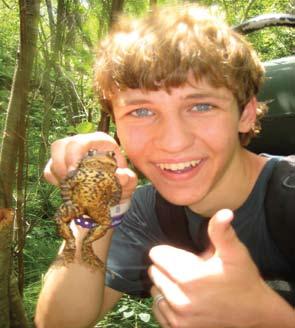
Family Owned
Since 1947
218-475-2330 www.rydensstore.com

Duty Free Liquor Cafe/Motel
10,000 U.S. and Canadian Souvenirs Gas
They’re Cool. You need one.
They’re Cool. You need one.
80 Skyport Lane Grand Marais, MN 55604
218-387-1687
Lake Superior Lake Superior www.superiorlightsource.com


Enjoy a day in the Boundary Waters Canoe Area Wilderness. Paddle the “Kelso Loop”three beautiful wilderness lakes in three hours. Lightweight canoe rental, maps, permits, and instruction available. (218) 663-7150 www.sawbill.com info@sawbill.com

LOCATED: Colvill
HIKE DIFFICULTY: Moderate
TRAIL QUALITY: Fair
DISTANCE ROUND TRIP: 2 miles
TRAILHEAD: The Kadunce River, by Colvill, is near milepost 118. Park on the lakeside of Hwy. 61. Cross 61 to the east side of the river, where a sign says “Spur Trail for Superior Hiking Trail.”
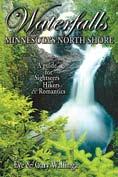
Set out from the trailhead. The trail and canyon walls rise through conifer and birch. Within five minutes, a series of steps takes you above the river to an overlook of the deep, narrow canyon. A cave is visible on the opposite wall.
Continue ascending. Within minutes you’ll hear a waterfall as the trail gently curves and a 10-foot path backtracks left onto a canyon headland. Navigating the path, you become a literal “tree-hugger.” The canyon walls are precipitous, but there is an almost hidden waterfall that pours into a little cave where the river takes a 180-degree turn. Return to the main path, and when the trail comes to a T, go right (upriver) or hard left, onto a short spur loop trail through the pines. This little beak of land is host to diminutive northland plants and flowers. Staying close to the canyon edge, you can catch another glimpse of the falls below.
Retrace your steps to the T. You’ll pass a cleared area on the left where you can hear and see what we consider the best waterfall on the river. Walk one more minute to another overlook at the top of the falls. The water emerges from a dark, narrow canyon, passing over a fissure only two or three feet wide, taking a steep, 12-foot slide to a horseshoe-shaped basin. Here the canyon walls are black and red. The river burrows into the shadowy depths of the earth. We call it “Heart of the Earth Falls.”
Upriver, you’ll encounter another smaller waterfall – a gradual, fleecy slide flowing around a corner. If the flow isn’t too great, notice the black and red snakeskin-patterned rock beneath the water. Continue to another waterfall, about three feet high, around the bend. A bridge and bench sit above the top of this slide. Cross the bridge. The trail continues upriver on the opposite bank, and after 100 yards, the main Superior Hiking trail continues left, uphill. The river trail continues as an informal path through the woods, where you’ll shortly fi nd a curving
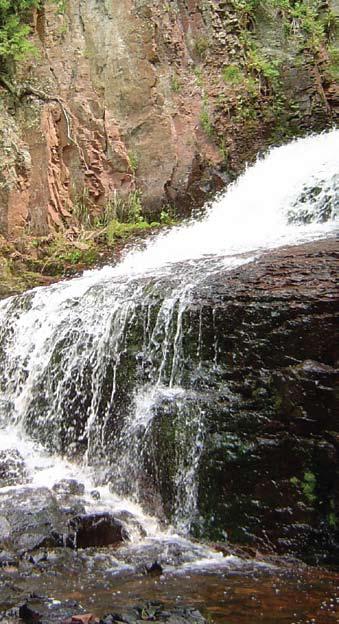
A section of “Heart of the Earth Falls” forms a watery veil over the rocks.
slide of shallow water, fl anked by moss. The trail narrows, heading away from the river a short distance. When it rejoins, look upstream for a shallow waterfall slipping over small rounded shelves into a pool.
Maple trees have joined the forest canopy as the trail takesafinalcurveandends.
by Elle Andra-Warner
Back roads along Thunder Bay’s waterfront take you up close to the city’s giant grain elevators. Fifty or sixty years ago, at the peak of grain shipping from the lakehead, there were 27 working elevators here; today only nine remain in operation. You can get close to elevators from three roads. The fi rst is Maureen Street (turn left after the Intercity bridge) with the most working elevators: Canada Malting, Viterra B, Viterra A, and Parrish and Heimbecker. A bonus along this route is a glimpse of the monolithic rusting iron ore dock where trainloads of ore once arrived from Atikokan’s Steep Rock Iron Mines to be loaded on freighters.

Less than five minutes from the last traffic light on Balsam Street and Highway 11/17, is one of Canada’s top rock walking sites. Located beside the Current River, the ancient rock outcrops are part of the Cambrian Shield.
Looking for adventure? Load up your ATV, rack your climbing gear or wriggle into your drysuit and embark on one of these true Thunder Bay backroads adventures. Needless to say, seek adventure suited to your experience level.
Climb the Sleeping Giant Got multipitch? Hike roughly four miles to the base of the Sleeping Giant and tackle one of the couple dozen climbing routes, including a couple of solid multipitch routes, such as Discovery (5.7). Most climbs are rated 5.5 to 5.8 and should be led with traditional gear. You can also scramble to the summit. See www. rockclimbing.com or www. summitpost.org.
A second road is on Shipyard Drive just past Fisherman’s Park and has two working elevators, Viterra C and Richardson’s. Great photo opportunities exist, especially if there is a ship loading. The third road (my favourite) is on Marina Park Drive. Turn right after the overpass at the “No E xit’’ sign and drive to the road’s end for a turnabout. Along the way there are some great views of the harbour, Sleeping Giant, an abandoned elevator, a float plane base and Richardson’s Elevator near road’s end.
While photographing at the mouth of the Current River last fall, I discovered a new gravel walking trail east of the road bridge on Shipyard Drive. The trail is part of Fisherman’s Park, a volunteer-driven public park project initiated by the North Shore Steelhead Association.
When complete, Fisherman’s Park will have paved trails, open air shelters, viewing platforms, a network of bridges connecting the islands, and storyboards about the riverfront’s rich history. This is where the Thunder Bay Silver Mining Company operated a mine from 1866 to 1870. In 1880s, the area was a top Port Arthur “tourist attraction,” referred to as an ‘’Edwardian waterfront pleasure ground” by one local newspaper.
The parking lot is the last reminder of urban life because once you step on one of the five colour-coded trails, nature surrounds you. There are over 6 kilometres of trails, the longest being the Orange Trail (1,600 metres) through the forest and the Red Trail (1,400 metres) which runs parallel to the river. Shortest is the paved barrier-free Forest Trail (775 m) through the mixed forest.
Walk, jog, cycle, in-line skate, paddle a kayak or canoe...take your leisurely time at one of Thunder Bay’s most historic wilderness areas at the north end of the city, Boulevard Lake. Created in 1901 when a head pond was created after the Current River dam was constructed, the two sides of the new lake were connected in 1910 by Black Bay Bridge. In 1913, a ring road was built around the lake as a park drive.
At the city’s south end, Chippewa Park has been a part of summer since 1921. The historic facility includes a log cabin dance hall/pavilion and the city’s only amusement park—complete with a roller coaster and wooden horses carousel (one of only three remaining in the world). The park’s Tourist Camp offers rental of 21 log cabins and 14 historic cabins, and offers a swimming beach and children’s playground.
Ride Crown Land
Pack a GPS device and a local buddy for an ATV expedition into Ontario’s extensive areas of Crown land. Mike Sawatsky, sales representative at North Country Cycle and Sports in Thunder Bay, recommends the Crime Stopper Explorer Series Maps to avoid that “oh crap, I’m lost” feeling. See www.atvontario.com and www.kestrelforestry.com.
Dive Superior Shipwrecks
Wrecked ships litter the bottom of Lake Superior, and the Thunder Bay stretch of coastline is no exception. There are also rivers and lakes to explore. Beginner divers can tackle close-to-the-surface wrecks, while expert divers can venture to the wreck of the Gunilda (off Rossport) or go searching for the secret “Ship Graveyard.” See www. scubaboard.com/forums/ ontario-fresh-waterfreaks/.





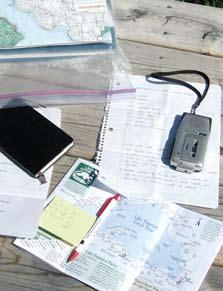
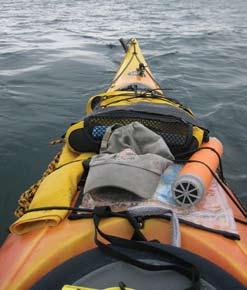
By Lucas Will
When we fi rst started planning our kayaking circumnavigation of Lake Superior, I remember thinking that all we had to do to navigate after paddling out of the Duluth canal was turn left. As long as we
kept the shoreline on our left, I reasoned, we wouldn’t need much in the way of maps.
After about five minutes of research, though, we realized we’d better bring a map or two.
With 3,000 miles of rugged shoreline, Lake Superior is a sea kayaker’s dream des-

We’ve got you covered for your next



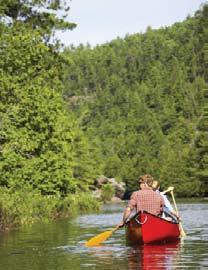






tination. Just as hikers look for a detailed guide to the footpath ahead of them, it was conceived in the early 1990s that kayakers would benefit from a similar guide.
The Lake Superior Water Trail is a cooperative effort between First Nations, Minnesota, Wisconsin, Michigan and Ontario to establish a water path all the way around Lake Superior. To date, there are a handful of regional trails that—it is hoped —will one day connect to form a full circle. Whether you’re looking for a weekend jaunt or a three-month paddling odyssey, the Lake Superior Water Trail can help you get around the big lake.
Most of the maps are printed on waterproof and tear-proof paper. We found them for purchase at local outdoor shops or guiding outfitters and were also able to see and order them online. The route descriptions include GPS coordinates, area amenities and important information about access points, rest areas, shoreline contours, and land ownership. According to the publishing agencies, Lake Superior Water Trail maps are not intended to be the sole source for navigation, but combined with topographical or nautical charts.
Throughout our trip around Lake Superior, we found these maps particularly useful for identifying “outs” should conditions get too big. And though we enjoyed fi nding our own campsites much of the time, we appreciated seeing where established ones were when we needed to respect private property. Camping permits are sometimes required, such as when traveling in areas like Wisconsin’s Apostle Islands National
Lakeshore and Michigan’s Pictured Rocks National Lakeshore.
Minnesota’s portion of the Lake Superior Water Trail was established in 1993 by the state legislature and is jointly maintained by the DNR and the Lake Superior Water Trail Association of Minnesota. For all of the Minnesota shoreline, we used a four-part map series published by the DNR to show us campsites and to help detail private and public land along the waterfront.
Wisconsin’s segment of the trail carpets its whole share of the Superior coast, from Wisconsin Point around the Bayfield Peninsula to the Montreal River, includin g all of the Apostle Islands – roughly 400 total miles of paddling.
The Keweenaw Water Trail wraps around the Keweenaw Peninsula from the lower entrance to the upper entrance of the Portage Canal. Farther east, after a short gap in the trail, the Hiawatha Water Trail follows a historic Native American paddling route 120 miles along the sandy southern shore from Big Bay to Grand Marais, Mich. This trail includes the circumnavigation of Grand Island off Munising.
Along the rest of Michigan’s Upper Peninsula and in Ontario, the water trail is still being developed. While permits aren’t required to paddle on the water trail itself, some of the areas require float plans, includin g Ontario’s Pukaskwa National Park.






By Shelby Gonzalez
Two reasons people travel to Africa are the dramatic landscape and the wildlife. Travelers shell out for airfare and safari fees and arm themselves with cameras in hopes of absorbing the beauty of the savanna and the majesty of the Big Five: lions, leopards, buffalos, rhinos and elephants.
You don’t have to cross an ocean to experience awesome animals. The Northern Wilds boasts its own Big Five: moose, wolves, black bears, lynx, and eagles. If you are sharp-eyed and lucky this fall, you may spot one of these creatures against the backdrop of the forest in full color.
Here are eight places and ways to enjoy the changing leaves—and wild denizens—of the North this autumn.
Ouimet Canyon Provincial Park, Dorion
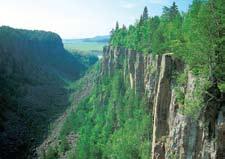
Ouimet Canyon is two miles long, 350 feet deep, and lures visitors with spectacular beauty and a tragic origin story. The canyon floor is said to be the resting place of Naninboujou’s daughter Naiomi, who was killed when the top broke off a mountain being moved by the giant Omett. Arctic flowers and plants inhabit the cool microclimate at the canyon floor; stick to the platfoms to protect the fragile fauna. Privately owned attraction Eagle Canyon is nearby. More information at www.ontarioparks.com.
Grand Marais
The Gunfl int Trail is actually a road – County Road 12, to be specific – winding its way from Grand Marais to the Canadian border lakes through the Superior National
Forest. The 57-mile-long Gunfl int is designated as a Minnesota Scenic Byway. Enjoy seemingly endless miles of autumn-fiery wilderness scrolling past your windows. Keep an eye on the sides of the road for leaping deer and maybe, if you’re lucky, a moose. The Gunfl int is studded with lodging and dining options, Boundary Waters access points, and historical sites, including the ChikWauk Museum and Nature Center. Details at www.byways.org
International Wolf Center, Ely
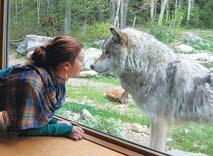
Have you ever met an ambassador? How about an “ambassador wolf”? Check out the International Wolf Center, where you can meet Aidan and Denali, the two northwestern subspecies wolves who inhabit the main outdoor enclosure, and explore the new


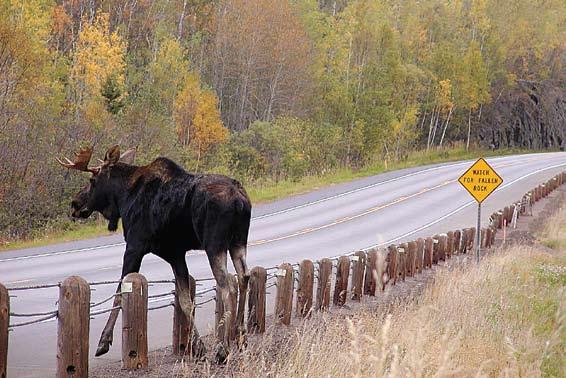
“Our Shared Planet” exhibit featuring life-size sculptures by Jim Ramsdell. Special events happen periodically, such as classes and the annual Howl-O-Ween Family Slumber Party. More information at www.wolf.org.
Vince Shute Wildlife Sanctuary, Orr
Bears are the stars of the show at the Vince Shute Wildlife Sanctuary, where you can stand on a wooden viewing platform with a 270-degree view of black bears going about their lives. The sanctuary comprises a diverse landscape aspen woods, meadows and cedar swamps—welcoming over 80 bears each year. Bobcats, lynx, eagles and timber wolves are occasional visitors. More information at www. americanbear.org.











The Depot, Duluth




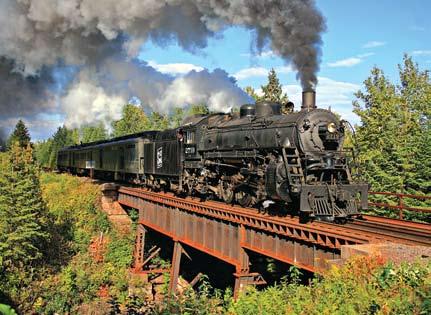
Hawk Ridge Bird Observatory, Duluth
The star of the show at Hawk Ridge is undoubtedly the main overlook on Skyline Parkway, where on a good day in the fall you can see thousands of broadwinged hawks, rough-legged hawks, golden eagles, bald eagles, red-tailed hawks and northern goshawks winging along the North Shore. Visit in the middle of the day on a day with west or northwest wind to maximize the number of birds you are likely to spot. Bring binoculars! Within Hawk Ridge Nature Reserve, there are a dozen different short and medium trails ripe for exploration. More information at www.hawkridge. org.
Silver Bay

| MICHAEL FURTMAN
ATV newbies and veterans alike can enjoy weaving through the colorful, critter-populated woods of Finland State Forest and Tettegouche State Park on the Red Dot Trail, 28 miles of woods broken up with bluffs and Lake Superior vistas. Connect with the Moose Run and Moose Walk Trails to lengthen your ride to 54 miles. Details at www.dnr.state.mn.us.
Sit back and let the colors come to you with a ride on the North Shore Scenic Railroad Fall Colors Tour. The train – a historic model from the Lake Superior Railroad Museum – departs the Union Depot at 10:30 a.m. on select dates in September and October, weaving along the lakeshore at a leisurely pace. After a two-hour layover in Two Harbors for lunch, shopping and sightseeing, hop back aboard for the return to the Depot and one more chance to take in the changing leaves. More information at www.northshorescenicrailroad.org.

Eagle Mountain Trailhead, Lutsen
Fill your lungs with fresh Boundar y Waters air on the way up Eagle Montain. Find the trailhead off Cty. Road 4 (before Lutsen), register for a free day permit, then follow the trail and signs 3.5 miles to the highest point in Minnesota, passing the blue gem of Whale Lake. Pack a picnic and look for the summit plaque. Detailed directions at www.summitpost. org. Want the views without the workout? Ride the Lutsen Mountains gondola to the summit of Moose Mountain instead. More information at www.lutsen. com.


Ouimet Canyon
Provincial Park Dorion www.ontarioparks.com
International Wolf Center Ely www.wolf.org
Gunflint Trail Grand Marais www.byways.org
Vince Shute
Wildlife Sanctuary Orr www.americanbear.org
Eagle Mountain and Moose Mountain Lutsen www.summitpost.org and www.lutsen.com
Red Dot Trail
Silver Bay-Beaver Bay www.dnr.state.mn.us
North Shore Scenic
Railroad Fall Colors Trail Duluth-Two Harbors www.northshorescenicrailroad.org
Hawk Ridge Overlook
Duluth www.hawkridge.org

your fall safari photos to editor@northernwilds.com and you could be featured in an upcoming issue.









It is no secret to readers of Northern Wilds that the northern forests are not lush, steamy jungles alive with brightly colored birds. Most of our birds have a sombercolored beauty. But there are always exceptions to the rule, like the brilliant scarlet of the male northern cardinal, the orange male Baltimore oriole, and the nearly neon yellow of the male goldfi nch in breeding season.


BY MICHAEL FURTMAN
Then there are the blue birds. Birds of blue we have. Most of you can quickly name two of them. The fi rst one to come to mind is the blue jay, which is very common in our area, and whose range overlaps the more boreal Canada jay. Next is the bluebird. We are at the northern edge of its range. Though often associated with open fields and meadows to our south, it is found in every Minnesota county, including Lake and Cook.
There is a third bird of blue in our area, one not often seen, and one whose coloration is so brilliant it might take your breath away when you fi nally spot one. I refer, of course, to the indigo bunting.
The fi rst indigo bunting I saw was on a ridge high above Lake Superior, one of those sunny spots that, because of shallow soils and a preponderance of rock, tend to
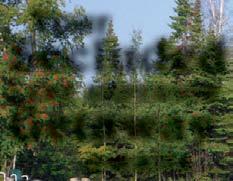
be dry and sparsely forested. It was a morning in May, and as I prowled along with my camera looking for migrating warblers, I fi rst heard, and then saw, a brilliant blue bird perched at the very top of a yet-to-leaf-out aspen.
It was mating season, and the little male bird sang his territorial tune at the top of his tiny lungs. As the warm morning sun struck the bird, I was dazzled by the intensity of its color.
About the size of a fox sparrow, indigo buntings thrive in forest margins and openings, like those along the Lake Superior highlands, as well as in burned-over areas and logging clear-cuts. While we often hear about declining songbird populations, according to the Natural Resource Research Institute in Duluth, this species is expanding in range and numbers in the Great Lakes region as we create more open habitats.
The female is yellowish-brown. Both sexes sport a short, thick bill, much like that of a grosbeak, with which they feed on insects, seeds and fruit.
In a way, the indigo bunting brings a bit of the tropics to the Northern Wilds. They are one of four tropical bunting species found in the United States and the only one
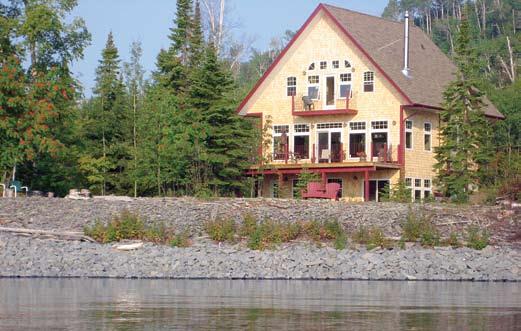


frequenting Minnesota. When the chill of autumn settles in, these lovely harbingers of summer wing their way south to winter in Cuba and Central America.
Besides all being found in Northern Wilds country, these three birds of blue share one surprising trait: their feathers aren’t really blue at all.
A male cardinal’s color is due to pigment in its feathers that absorbs light wavelengths except those our eyes see as red. But blue isn’t due to pigment. Despite breathtaking coloration, the blue color we see in blue jays, bluebirds and indigo buntings isn’t from pigmentation but from feather structure, as are all iridescent bird markings, such as a mallard drake’s head. Minute particles in the feather reflect and scat-
ter the very short wavelength of the color blue, much in the same way that miniscule particles in Earth’s atmosphere scatter blue light, resulting in the familiar “sky blue” of a summer day.
If you were to take a feather from any one of these blue species of birds, and hold it up between you and the light source, it will actually look brown.
There’s one more cool thing about these blue feathers. They look the same when viewed from any angle. Iridescent colors result from a different feather structure modification, and so change with the angle of viewing, which is why a mallard drake’s head can look green or purple or blue, depending upon the angle.


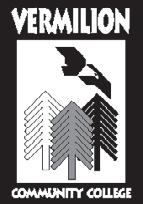










THE SUMMER full service bikeshop, rentals, kites, rock climbing equipment

Story and photos by Eric Chandler


10% off Sawtooth Mt.Bike Challenge Sat., August 27 www.sawtoothchallenge.org

www.SuperiorNorthOutdoor.com


Specialty Coffee - Whole Leaf Tea - Gourmet Soups - Bakery Goods - Homemade Sandwiches
We go to incredible lengths to select the nest individual beans for your locally owned Dunn Bros Coffee Stores. Each single-origin bean reects the unique nuances of the farm where it was grown. We take great joy in offering different varieties of coffee roasted daily in our store. We think you’ll take great joy in drinking them.
Dunn Bros Coffee
2401 London Road Duluth, MN 55812 (218) 724-8838
2 Blocks West of Blackwoods Restaurant, across from the Edgewater Hotel and Waterpark
Duluth has a bounty of trails: cross-country ski trails, the Superior Hiking Trail, and the Lakewalk. Not enough for you? How about 100 miles of singletrack woven into the city? It’s called the Duluth Traverse, and it is the vision of the Duluth-based organization Cyclists of Gitchee Gumee Shores (www.coggs.com).
There are already four destination mountain biking trail systems in Duluth: LesterAmity, Hartley Park, Piedmont, and Spirit Mountain. The goal of the Duluth Traverse is to expand some of the four existing trail systems, link them up, and create new destination systems.
While it is an ambitious and long-range plan, momentum is building. I asked Adam Sundberg, chairperson of COGGS, to explain the next steps.
“We have been approved by the county and city to add five additional miles in Lester and five miles in Brewer Park (across Haines Road from Piedmont). We also hope to start connecting Lester to Hartley next year as well.”
This spring, the International Mountain Bicycling Association (IMBA) donated the time of their most experienced trail designer to scout the terrain in Duluth. They are creating a plan for a 20-mile system in Mission Creek that they hope to start next year.


Early cost estimates were $2,500/mile, pushing fundraising needs to $200,000 for the creation of the Duluth Traverse. The good news is that grants and private donations have already raised $26,000. This amount makes the club competitive for a 3:1 match from a Parks Legacy grant that could leverage over $100,000.
However, Sundberg says that initial estimates were “probably low, and it will be more like a $500,000750,000 project.”
Besides making donations and volunteering for trail work, people can help make the Duluth Traverse vision reality by donating their skills. “The big help is people with unique skills using said skills to meet a need. For instance, we have volunteers where their day job is writing grants, GIS, fundraising, community relations, etc. Having those professional skills at our use is really helpful.”
This is exciting to me as I reconnect to the sport and introduce my kids to the game. I took my son to last year’s inaugural Great Hawk Chase mountain bike race on the Lester-Amity system. It was his fi rst race and he had fun. I asked where beginners fit into the Duluth Traverse plans.
“Basically,” Sundberg says, “we want a portion of each
trail and all of the trails connecting hubs (Lester to Hartley, Piedmont to Spirit) to be beginner-friendly. We realize there is a lack of easier trail here because there haven’t been many trails purpose-built for mountain biking in Duluth, they are just hiking trails that mostly have been created by use. But Lester and Mission Creek have different soils and no rock, which makes them much easier places for easier trails.”
I asked what makes the Duluth mountain bike scene special. Sundberg’s quick answer: “Elevation change, views, rock, a town of 85,000 people.” His excitement about Duluth trail development is palpable as he explains, “We can have riding every bit as good as Rapid City, CAMBA [the Chequamegon area], UP of Michigan, but we have a town that is much more attractive for arts, culture, kids’ activities, shopping.
“There are very few urban areas that have 100 miles of mountain biking in them. You can count them on one hand and they are nowhere near here. It’s truly a unique situation and very exciting to be a part of.”
Okay, okay, I’m sold. Bring on the Duluth Traverse!
Story and photo by Joan Farnam
There’s nothing like the taste of a homegrown tomato or a handful of sugarsnap peas fresh off the vine to tell you that summer is here. Fresh, locally grown vegetables are not just available to gardeners, either. Consumers from Thunder Bay to Duluth to the Iron Range can fi nd locally grown produce in an increasing number of venues all over the region this summer.
Farmer’s markets, co-ops and grocery stores as well as many restaurants are depending on local producers to provide meats, dairy products and fresh fruits and vegetables for their customers.
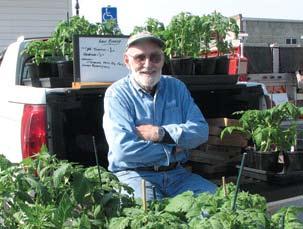
“It’s very exciting, and it’s also happening regionally and nationwide,” says Melinda Spinler, a grower for a CSA (Community Supported Agriculture, a local food subscription service) in Cook County. She serves on the board of the Minnesota Sustainable Development Project and is also active in the Lake Superior Chapter of the Sustainable Farming Association.
One reason for this surge of interest, she maintains, is taste. “The taste is more intense, and they’re served at their peak.”
More often than not, local produce is organic. Consumers today are much more aware of wanting to eat foods that haven’t been treated with chemicals, Spinler noted. There’s an economic incentive, too. By supporting local growers, you are helping the local economy and providing a base for food security in the future.
All of these factors play into the increasing consumer interest in buying food that is grown in their neighborhoods, said Ardy Nurmi-Wilberg, executive director of the

Iron Range Partnership for Sustainability, which is based in Virginia. The partnership was formed three years ago as an information and networking hub for sustainability. Its annual convention, called the Iron Range Earth Fest, has become one of the biggest gatherings of its kind in the state. The “Everyday Guide to Sustainable Living on the Iron Range” includes a guide to fi nding farmer’s markets and local food producers in the region.
Duluth has one of the oldest farmer’s markets in the region (it celebrates its 100th anniversary this year) and producers sell fruit, vegetables and crafts as well as eggs and poultry.
Thunder Bay is another a great place to fi nd locally produced food. There are three farmer’s markets there during the summer as well as pick-your-own opportunities at Belluz Farms and Mountain View Farms and locally made cheese at the Thunder Oak Cheese Farm. It’s always advisable to call ahead at pick-your-own establishments to see what’s available.



Downtown Artisan & Farmers Market
507 Victoria Ave. E.
11 a.m. to 2 p.m. Thursdays
9 a.m. to 3 p.m. Saturdays (807) 622-1718
www.downtownmarket.org
Thunder Bay Farmer’s Market
Dove Building, CLE grounds
8 a.m. to 1 p.m. Saturdays 3:30 -7 p.m. Thursdays www.thunderbaycountrymarket.com
Thunder Bay Farmer’s Market
Victoriaville Shopping Center
9 a.m. to 4 p.m. · (807) 622-3316
Thunder Oak Cheese Farm RR#3, Boundary Dr.
Monday to Saturday, 9 a.m. to 5 p.m. (807) 628-0175 · www.cheesefarm.ca
Belluz Farms
752 Candy Mountain Rd. (807) 475-5181 · www.belluzfarms.on.ca
Call ahead to confi rm season and hours.
Vanderwees Home & Garden
6488 Mapleward Rd.
9 a.m. to 6 p.m. daily · (807) 767-3666 www.vanderweeshomeandgarden.com
Mountain View Farms Route 6, Candy Mountain Dr. (807) 475-9575
Cook County Farm & Craft Market
Senior Center parking lot 9 a.m. to 1 p.m. Saturday.
Berglund’s Dairy
140 County Rd. 56, Maple Hill
Open daily · (218) 387-2591
Ely Farmer’s Market
Whiteside Park
Tuesdays, 5:30 p.m. to 7:00 p.m. (218) 365-6072 marcialoon@hotmail.com
Tower Farmer’s Market Off Hwy. 169, next to train depot, Fridays, 4 p.m. to 6 p.m. fatchickenfarm@gmail.com
Virginia Farmers Market 1301 8th St. S. at Kunnari’s tent Tuesdays and Fridays, 11 a.m. to 6 p.m.
Fat Chicken Farm sells direct or through Ely and Tower Farmer’s Markets · (218) 749-2186 www.fatchickenfarm.com
UMD Market Day in the Plaza 1120 Kirby Drive
Wednesdays, 1:30 to 4:30 p.m. www.d.umn.edu/umdhr/wellness /farmersmarket
Duluth Farmer’s Market 14th Ave. E. and 3rd St. Wednesdays and Saturdays, 7 a.m. to noon · www.duluthfarmersmarket.com
Carlton County Farmer’s Market Scanlon, 9 a.m. Saturday until sold out (218) 384-3269


By Kate Watson
“Spa trips,” chiffon wraps and cocktail hour—hardly the terms you’d expect to be bandied about when discussing Boundary Waters canoe travel. But for one adventuring group of 40- and 50-something women, these indulgent touches are just part of the paddling fun.


They call themselves the BWISBs. (More on the name in a minute.) They have been taking canoe trips together for the past twenty years.
Their tradition stems back to Minnesota summer camp when they were still in their teens. After numerous childhood summers together, the women scattered across the country and lost touch, but at a camp reunion years later they decided to revisit their childhood adventures. They organized a weeklong canoe trip. The tradition is now two decades strong.
“After our fi rst time back out together, we said, ‘Boy, we can do it!’” says Leigh Johnson, one of the founding members of the group.
The name is an ode to their humor. They came up with it after their inaugural trip, when they experienced the complications of using the bathroom while wearing onepiece swimsuits. The next year they chose to wear sports bras and shorts instead.

“ gro w v
“Now we’re grown up and we can bring vodka in our Nalgenes.”
The

BWISB stands for “Big Women In Sports Bras.”
“We decided to honor the sports bra. Big women in sports bras,” Johnson says. “We thought, ‘That’s it, we’ll just be the BWISBs!’”
While they certainly know how to have fun, says Bill Hansen, owner of Sawbill Canoe Outfitters in Tofte, the BWISBs are serious campers and canoeists.
“They’re amazing, funny, strong independent women, and they’re obviously not afraid to make fun of themselves. They take pretty tough trips and they just have vast enthusiasm for it. They epitomize the spirit of having fun in the wilderness.”
The BWISBs were in the vanguard of a growing trend of women journeying into the wilderness, Hansen continues
“There has been a distinct trend since the
mid-’70s of professional women doing vacations in the Boundary Waters like the vacations men have been doing forever. Back then, about 90 percent of the people visiting the BWCA were men. Gradually that has changed. Now it’s more like 60 percent men and 40 percent women. Women are seeking out wilderness adventure.”
Despite the trend, many of Johnson’s acquaintances were initially confounded by the idea of taking a wilderness trip with other women, posing plaintive questions like “Who will take care of your husband and children?” and “Won’t you freeze?” But her family was supportive.
“Being from an all-girls camp, there’s something about groups of women who have to do it on their own. The trips are
empowering, I don’t care what age you are. It’s this sense of ‘We can do this, we don’t need boys here!’ We liked that feeling it’s like being back at camp, but now we’re grown up and we can bring vodka in ou r Nalgenes.”
That’s where cocktail hour comes in. The BWISBs enjoy evening cocktail hou r (during which they sometimes wear chiffon wraps over their camp clothes) and singing around the campfi re. Some years they fashion their canoe excursions to be what they’ve termed “spa trips,” consistin g of base camping with day trips throughout the week.
Whether a spa trip or not, the annual outing serves as a soul-refreshing escape for the members of the group.

Story
photos by Shelby Gonzalez
Long before the concoction of aniline (coal-tar-based) dyes that yield Technicolor hues, people dyed with natural materials gathered in their backyards. Everyday organic materials like plants, wood, mushrooms, roots, bark and lichen can be used to dye fibers and fabric, producing rich, earthy colors.
You probably have a dozen different dyes in your household right now. How about coloring your next knitting project with spinach, coffee grounds, turmeric, sumac berries, nettle, dandelion, carrot tops, beets, pomegranate juice, orange rinds, blackberries or even hedge clippings?
Last fall, I spent three days at the North House Folk School exploring the art and craft of natural plant dyes under the tutelage of veteran dyer Karen Rognsvoog. She gave the class a head start on the process by bringing in brown paper bags brimming w ith dried plant material, including grape, sweet fern, marigold, Queen Anne’s lace, purple coneflower, buckthorn, rose hips and St. John’s wort. The next step was preparing the dye baths.
Armed with garden shears and work gloves to protect our hands from the plants w ith poky parts, we chopped the colorbearing parts of the plant material into sturdy plastic buckets. Someone shaved curls off a block of osage wood. Someone else crushed a bag of black walnuts.
“Careful,” Karen warned. “They’ll stain your hands.” Such a dye is called a “fugitive” dye.
We labeled the buckets, fi lled them with tap water and set them on a table to soak overnight. We also washed the raw materials we would be dyeing: silk scarves, wool yarn and cotton squares.
While the dyes were steeping, we piled into two cars and drove to public ditches and a big burn pile to gather more material, including birch bark and dogwood.

September was late in the season to be harvesting and pickings were slim. August is harvest time for a lot of natural dye plants in the Northern Wilds, like blackberries and blueberries.
Back at North House, we poured the bucket contents into big stainless-steel kettles, set the kettles on burners and brought the liquids to a boil. In teams, we poured each kettle’s contents through a strainer to remove the plant material while great clouds of steam billowed up and slicked our faces with moisture. We returned the kettles to the burners and added mordants.
Mordants are dye additives that help “open” the fibers so they will accept dye better, make the dye fade-resistant, and can deepen or alter the dye color. We used only natural mordants: alum, iron, tin and copper (also called blue vitriol), which gives a greenish tint. Colonial-era clothing, Karen explained, was often gray because they dyed clothing in iron pots.
To round out our selection of dye colors, we also mixed up a few purchased—but still naturally derived—dyes. One, cochineal (CO-shin-eel), is a pink-red dye that comes from the powdered shell of a tropical beetle. Another, indigo, generates a blue as vivid as an aniline dye but comes from the leaves of the plant Indigofera tinctoria.
Dye It Yourself Books on natural plant dyes abound. Karen recommends Natural Dyeing by Jackie Crook (Lark Books, 2007) and The Craft of Natural Dyeing by Jenny Dean (Search Press, 1994), among others. She will be teaching “Natural Plant Dyes” again on Sept. 30-Oct. 2. See www.northhouse.org for details.
One by one we slipped our skeins, scarves and cotton squares into the pots. The longer you left it in, the richer the color. You could even switch a skein from one color to another to layer the shades. Each time someone disturbed a pot, it released the smell of plant matter and mordant. Leaning over a kettle of bubbling green dye, I felt like a cartoon witch. After the materials absorbed the dye, we fished them out with long wooden spoons, rinsed them and draped them over racks to drip dry.
“I love this orange.”
“Look at that pink!”
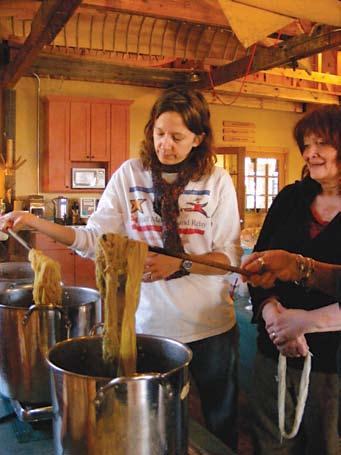
only events. “You’re never going to get the exact same color again.”
Karen pointed out that variable plant potency makes natural dye colors one-time-

Most of the dyes yielded muted, earthy shades, as you might expect. Grapevine and tansy (with iron) turned out taupe and sand, respectively. Black walnut was a weak-coffee brown. Some of the dyes were surprisingly bright. Osage orange was like a goldenrod crayon. Logwood was a deep royal purple. My favorite dye, to my surprise, was buckthorn (with copper), which produced a soft sage green.

As a young man growing up in Northwestern Ontario, my opinion of black bears was pretty dim. Everyone I knew considered them vermin and not worth hunting. Bears, I was told, were inedible and “stunk” as they only lived in dumps. Most deer and moose hunters considered hunting bear beneath them.
Now I know better. Bear hunting is one of the most exciting and challenging pursuits a hunter will ever undertake.


You can get that thrill from a tree-stand hunt, but if you want to know what it’s like to match wits with a predator on its own turf, try stalking bear. There is a mix of excitement and primal fear when stalking a bruin that’s unlike any other hunt in North America. If you don’t get pumped trying to sneak up on a refrigerator-sized bruin, buddy, you can’t be breathing. My fi rst real bear stalk took place two




years ago in a huge blueberry patch north of Thunder Bay. It was late September, but the temperature felt more like early August. A friend and I were scanning cut-overs, looking for bears feeding on the late blooming berries. My partner had already taken a nice boar in the berries a week or two before, and had seen several other really big ones as well. You can fi nd bears feeding in the open wherever there is abundant natural food. Blueberry cuts, cornfields and old apple orchards all have bear potential.
As the daylight waned, we spotted an enormous black bear striding out of a black spruce swamp into a cut that was glowing blue with berries. The bear was moving at a rapid pace and was about 250 yards away. It seemed unaware of us and disappeared down the back of a hill. With rifle tightly in hand, I headed in.




The bear was not visible as several dips and rises obscured the view. The walking was rough, it was getting dark and the bugs were off the charts. It felt like the bear was going to suddenly appear in my face. My heart was beating so hard I could hear it in my throat.
About 150 yards in, I topped a rise and saw the big boar feeding in a berry patch. It looked about the size of a Volkswagen Beetle.
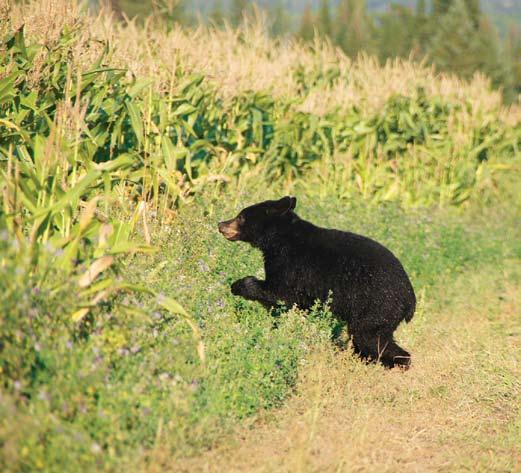
The gun went up, and the 9 power scope found the bear’s shoulder.
The rest of the experience is a blur, but stalking up on my downed bear was one of the more gut-wrenching things I’ve ever done. However, the 180-grain bullets had done their work. It was a huge beast and
weighed in excess of 400 pounds. Its pelt was a thick ebony and it smelled like the woods. A simply gorgeous creature. That bear was absolutely stuffed with berries and had been feasting for days, if not weeks. I am also happy to report that the meat was as tender and tasty as the fi nest deli pork.








Bear hunting has only increased the admiration and respect I have for these great animals. They are perfectly suited to the north woods and are a cunning quarry. Ontario has a healthy and growing population of these animals and the harvest is well-managed. If you want to try a truly thrilling hunt, stalking bears is a good place to start.

Chinook salmon are best described as “locomotives with fi ns.”

By Shawn Perich
Recently, I listened to a friend’s tale about the salmon that got away. As my friend put it, the moral of the story was, “That’s why they call them kings.”
Swimming in Lake Superior is a Pacific salmon introduced 40 years ago when native fish stocks were depleted from the onetwo punch of industrial fishing and the invasion of parasitic sea lampreys via the St. Lawrence Seaway. Known as the Chinook or king salmon, its population expanded during the 1980s as it fi lled a void in the lake’s predator base. In September, streams along the North Shore were stuffed with spawning salmon topping 20 pounds, which attracted hordes of eager anglers.
As quickly as the salmon population expanded, it began declining during the 1990s as fish managers successfully restored native lake trout in Lake Superior. Today the salmon occupy much a smaller niche in the big lake and the population is primarily supported by natural spawning in large tributary rivers. Today’s kings are smaller and not as common, but remain a highly prized catch.
Trollers typically catch kings during the few weeks when the summer sun warms
the icy lake’s surface water. Even then, salmon action is happenstance. Just because salmon are swimming beneath you doesn’t mean they are willing to bite. But when they do, look out!
A king is best described as a locomotive with fi ns. Once hooked, even small kings make long, powerful runs—just like a runaway locomotive. Bringing one to the boat is inevitably a lengthy battle that doesn’t end until the salmon is in the landing net.
The average summertime king weighs from 3 to 8 pounds, although they may run somewhat larger in Canadian waters. You may also catch larger ones when they make their September spawning run into tributaries—again in Canada. Regardless their size, kings are terrific table fare.
So how can you get in on the action? Trolling on Lake Superior can be effective in August and September, especially if you go fishing around dawn and dusk. During September, kings start to congregate near river mouths in preparation for their spawning run. They enter the streams when autumn rains raise river levels, usually during the latter half of the month. In Minnesota, the salmon run is negligible, but good numbers go up the Wolf, Black Sturgeon and Nipigon Rivers in Ontario.
If you don’t own a boat or are new to Lake Superior fishing, consider a day charter. Charter services are available at every North Shore port and are relatively inexpensive. Charter captains have the know-how and equipment to catch Superior’s trout and salmon. Some captains prefer to target the more-numerous lake trout, so if you want to catch salmon, be sure to tell the captain when you book your charter.
While walk-ons are possible, most captains are booked during the prime summer fishing season, so plan ahead. If you want to learn about Lake Superior fishing, spending time on the water with a charter captain is the best way to do so. Most are happy to share their fishing knowledge with customers and to show you how to use trolling gear.
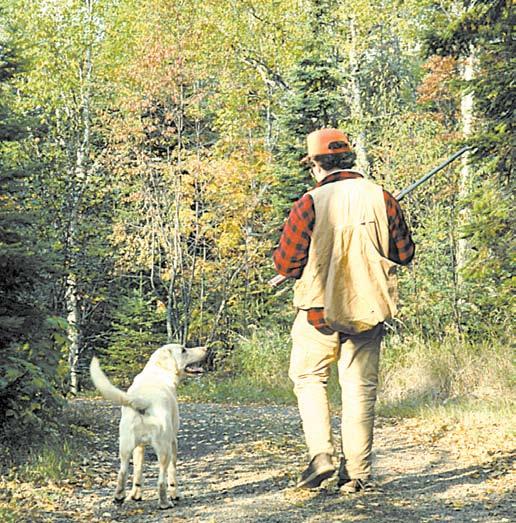





Despite the term “doggy paddle,” not every canine is a strong swimmer. If you plan to take your dog on a canoe trip or water-related adventure, you might want to invest in a life jacket. Ruff Wear makes all manner of dog gear, and the quality and function of their dog life jackets is solid. The highlighted feature is the positioning of the flotation cells, which cause your dog to float horizontally in the water, making swimming natural and easy. Ruff Wear’s dog life jackets are offered in two styles, the Portage Float Coat and the beefed-up version, the Big Eddy Float Coat.

The Portage (MSRP $49.95) reviewed here, comes in sizes XXS to XL. The life jacket is fully adjustable with two buckling belly straps and a buckle and Velcro tab around the neck. The top of the life jacket has a handle for plucking your pup from the water and a D-ring for attaching a leash. The portage is offered in both bright green and orange with reflective taping for better visibility both in the water and out. More information at www. ruffwear.com.
–Kate Watson

East Superior Street, Suite 544 Duluth, MN 55802
or toll-free 877-261-5612

provide enough variety in
product line to compliment the unique “character” of almost anyone’s home or cabin.
We all know we are supposed to be drinking more water, but unless you’re sitting at your desk or riding in a car, it can be a real pain to carry that jug around. Enter the Go Caddy. This microfiber bag lets you tote water along on walks, shopping excursions, sports events, seminars and any other place you need to stay hydrated. It can handle a variety of bottle sizes up to 1.5 liters.
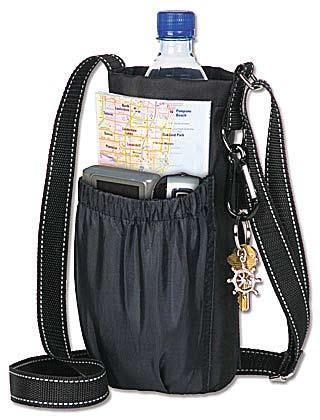
The long, adjustable strap makes it easy to change length for wearing it over your shoulder or across your body sling-style. It also has additional pockets. One dual pocket is pleated and closes with a secure Velcro fl ap. This space is ideal for notes, credit cards, money and license/identification.The other pocket is elastic and works well for easy-to-grab items like a cell phone, or glasses. There’s even a metal clip for your keys or your hat. The only thing I disliked about the Go Caddy was the roughness of the Velcro on my hand when I would reach into the pocket to grab something. Other than that, it was a great size and held all the items I needed with me. MSRP $19.99. Details at www.bvtproducts.com.
-Amber
Pratt

Even near Lake Superior, there are days in the summer when keeping cool outdoors is an unavoidable priority. So when we received a Magic Cool Personal Cooling Cloth by Grabber at a trade show, I couldn’t wait to give it a try. The neat thing about this cloth is that you just add water – no refrigerating or freezing needed. As long as the Magic Cool fabric is damp, it stays cool to the touch. This was great for cooling off after my morning run and to soothe the sore muscles in my back. When I fi nished using it, I would just hang it to dry and it was ready the next time I needed it.
At 15 by 25 inches, the cloth is a good size for packing along in a backpack, bag or purse. It comes with a fastener so you can attach it to your bag to dry. This product can be purchased at a number of retailers in the Northern Wilds. MSRP $15.99. More information at www.grabberworld.com
-Amber Pratt
2-3 cups chopped fresh cilantro
3-4 chopped green onions
2 cloves garlic, chopped
Fresh lime juice (at least one lime)
Olive oil
Chopped fresh jalapenos, to taste
Salt and pepper
1/2 pound softened butter
Put cilantro in a food processor with green onions, garlic, lime juice and process well, until it’s a paste. Drizzle a little olive oil into the mixture and then add chopped jalapeno, salt and pepper to taste.
Put softened butter into a bowl and add the cilantro mixture. Mix well and let sit for an hour or so before using fresh to blend the flavors. To freeze, fill ice-cube trays with mixture until frozen. Store cubes in freezer bags until ready to use.
This recipe was shared by a potter who made this for a potluck after a successful firing at Dick Cooter’s kiln in Two Harbors.
1 good-sized winter squash, buttercup or turban variety
1/4 cup butter
1 red pepper, chopped
Grated cheddar cheese
Salt and pepper
Heat oven to 350 degrees. Cut out a lid from the top of the squash. Remove seeds and inner membrane, put in 2 tablespoons of butter, a little salt and pepper, replace cap and bake until squash is cooked.
Remove from oven and carefully scoop out flesh into a bowl, making sure to keep the outer shell intact. Add the rest of the butter, red pepper, and salt and pepper to the bowl and mix well. Put back in shell and top with grated cheese.
Bake until the cheese is bubbly and browned, about 30 minutes. You can run it quickly under a broiler at the end to crisp the cheese.
Replace lid and serve. This is always a favorite at potlucks. The red pepper is just incredible in the squash. Some have suggested adding green chilis to the mix, which would add another layer of flavor.

BY JOAN FARNAM

We reap what we sow in August and September, and they can be the most exhilarating months of the year for gardeners. I write this with my fi ngers and toes crossed, however—no harvest is guaranteed up here in the Northern Wilds.
If our soil was in great condition…
If it rained or we had a good source of water…
If we planted varieties that do well in northern climes…
If we tended, weeded and top-dressed until the plants were so healthy they kept diseases at bay and insects couldn’t keep up…
…then it’s almost unbelievable how much we can grow in the summer months.
This year, we had a cold spring that lasted well into June and everyone who didn’t have a green house was wondering if they’d even get a tomato or winter squash. There was very late patchy frost a few nights, too, deadly to baby bean plants.
But then summer arrived with a bang. Suddenly there were 70-degree days and balmy nights, and vegetable gardens were transformed overnight. I was shocked one morning, for example, to realize that I had planted my onions too close together. For two months, the bed looked great – there was plenty of room between the plants – but one morning I went out there and it looked like they had doubled in size overnight, and I had a big problem with overcrowding. Exciting times, no doubt about that.
The feasting on peas and green beans, tomatoes and peppers fresh out of the garden is such a perk for our labor, but at some point, we realize that it sure would be great to be able to save some of what we grow for the winter months. That’s when another set of skills comes into play: canning, freezing and drying.
Home preservation is a growing trend in the state these days as more and more people put in vegetable gardens, said Diane Booth, Cook County Extension agent. “I had 21 people take home preservation classes this year,” she said. Requests for information keep coming in.


The author’s garden in August, growing like crazy with the harvest not far away.
There are lots of great books out there that talk about how to safely can tomatoes or how to store winter squash so it lasts through February. A few titles include The Ball Blue Book Guide to Preserving, which covers all the ins-and-outs of canning, Dry It, You’ll Like It, by Gen MacManiman, the ultimate source on drying foods, and Root Cellaring: Natural Cold Storage of Fruits & Vegetables by Mike and Nancy Bubel.















Free Shipping on New Canoes or pick up in Ely, MN and get $100 off
Lightweight Kevlar Canoes.
Ask about Kayaks for your cabin.
800-223-6565 218-365-6746 Piragis Northwoods Company Used Canoes online at: www.piragis.com
Devil Track Lake
Lovely 3BR/3BA lakehome; beautiful cherry kitchen; fireplace; tons of windows; separate studio apt; det’d garage & even has a boat slip!! $469,900 Coldwell Banker North Shore www.CBNorthShore.com 800-732-2131
Cascade Vacation Rentals Vacations, Reunions, Weddings, Romantic Getaways www.cascadevacationrentals.com 800-950-4361
CLASSIFIED RATES: $5 per line. 3 line minimum. 50 characters per line including spaces and punctuation. All classifieds must be submitted in writing via mail, fax or email. (If emailing, please call to pay by credit card) Cost of ad is per insertion. Additional Options: Bold & CAPS: per word: .50¢/ Entire Ad: $9.00. Centered: $5.00. Fax or mail advertisment to: Northern Wilds Media, Inc, PO Box 26, Grand Marais, MN 55604 Phone/Fax: 218387-9475 Email: class@northernwilds.com. For display classified ads (with photos/logos/boxes), please contact Calie Vannet at 218-387-9475 or email calie@northernwilds.com. Issue Deadlines: The 12th of these months: Jan, March, May, July, Sept




In July, we (Northern Wilds publishers Shawn Perich and Amber Pratt) attended the annual conference of the Outdoor Writers Association of America at Snowbird Resort in Utah. Our intent was to mingle with and learn from our peers and to breathe some fresh mountain air. All aspects of the trip were a success.
The three-day conference was packed with activities, including a keynote address about the emerging “locavore” movement by Hank Shaw, who operates the popular blog Hunter Angler Gardener Cook. We picked up a few tips from his presentation and you can expect to see more on feeding yourself in future issues of Northern Wilds. The conference also included hands-on demonstrations of outdoor gear and shooting equipment. Amber, who has minimal shooting experience, proved to be a natural Annie Oakley.

182 S. Algoma St. Thunder Bay, Ontario, P7B 3B9 or online at www.borealispress.com $18.95 C


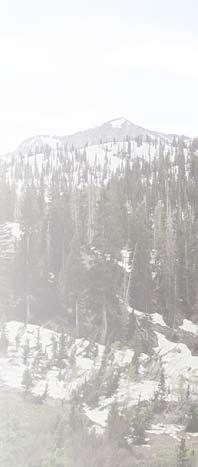



As for fresh mountain air, we found time to hike in the Wasatch Range. Amber and her family also visited Antelope Island on the Great Salt Lake. In fact, we left for home wishing we had more time to explore Utah’s wonderful outdoor recreation opportunities.

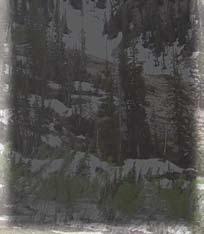

USA: Beaver Bay/Silver Bay Jimmy’s Pizza 16, Whispering Pines Motel 6 Duluth
Bradley C Jenson 26, Country Inn & Suites 4, Dunn Bros Coffee 20, Fond-DuLuth Casino 4, Minnesota Logger Education Program 17, Permit to Carry 24, Stonegate on Superior 6, Sustainable Forestry 2, Yarn Harbor 23 Ely/Range Cities Boundary Waters College 19, Conservationists with Common Sense 12, Frontier Log Railings 26, North American Bear Center 27, Piragis 22, Raven Productions 29 Grand Marais Anderson Aero 16, Buck’s Hardware Store 25, Chik-Wauk 19, George Maruska 17, Golden Eagle Lodge 32, Grand Marais Art Colony 6, Grand Marais State Bank 8, Gunflint Pines 21, Joyne’s Ben Franklin 4, Lake Superior Rock Lamps 12, The Landing 7, Loon’s Nest Gift Shop 21, Municipal Pool 18, My Sister’s Place 26, Recreation Areas 6, Sawbill Canoe



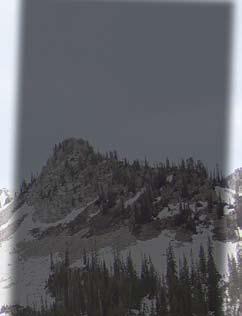




Outfitters 12, South of the Border Cafe 21, Stone Harbor Wilderness Supply 19, Superior Lumber & Sports 24, Superior North Bike Shop 20, White Pine North 4, WTIP 7 Grand Portage/Hovland Grand Portage Casino 9, Ryden’s 12 Lutsen/Tofte/Schroeder/Finland Chateau LeVeaux 4, Our Place 10, Wolf Ridge Environmental Learning Center 11 Twin Cities Adventure Publications 28, Parks & Trails Council of Minnesota 10, Midwest Mountaineering 16 CANADA (Ontario): Thunder Bay Ahnisnabae Art Gallery 30, Amethyst Gift Centre 27, Bill MacDonald 28, China House 11, Comfort Inn 30, Dog Lake Resort 13, Gear up for Outdoors 14, Global Flags & Banners 30, Sunrise Cottage on Superior 18, Valhalla Inn 31






Ian McAllister GREYSTONE BOOKS, $19.95
Every now and then, an author comes along who gives conventional wisdom a gentle nudge and causes us to look at the natural world in a new way. Ian McAllister, a naturalist who has observed and photographed the daily life British Columbia’s coastal wolves for 20 years, provides a lucid view of these fascinating, family-oriented animals. Importantly, he suggests the ancient relationship between man and wolves was much closer than the antagonistic (on the part of humans) relationship we have today. In his work, wolf packs came to recognize and accept him near their den sites an d feeding areas. He also found coastal wolves often locate their dens in th e remains of ancient native villages, perhaps suggesting an ancient symbiosis. We may have forgotten this relationship, he suggests, and wolves are waiting for us to remember it. —Shawn Perich
Bill McDonald
BOREALIS PRESS
$18.95

By Deane Morrison UNIVERSITY OF MINNESOTA STARWATCH
Imagine a poetry society in Thunder Bay comprised of quirky poets from all walks of life. Then imagine a published anthology of poems from the Bell, Book & Candle Poetry Club of Thunder Bay. With his tongue firmly placed in cheek, this is what author Bill McDonald has done in Brandy & Summer Wine. This reviewer doesn’t know Thunder Bay well enough to fully appreciate the sharp satire, but suspect those who do know the city may find a few inside jokes within the pages. —Shawn Perich



Elle Andra-Warner


David Thompson was an extraordinary explorer and geographer who mapped much of western Canada and was the first European to navigate the entire Columbia River. Anyone interested in the history of the fur trade will find this book especially interesting, because it makes the connection between the trading posts of the western interior and the fur routes passing through northern Lake Superior. As always, the author’s concise writing style delivers an incredible amount of information in an easy to read format.—Shawn Perich.

The end of summer brings the laid-back water constellations into the evening sky and gives us our last good look at the stars of Scorpius and Sagittarius. Those two constellations move from south to southwest during August and September. Scorpius, slithering across the southern horizon, leads Sagittarius and its starry Teapot toward their seasonal oblivion.

During both months, the Summer Triangle soars in the south. It comprises Deneb in Cygnus, the swan, and Vega in Lyra, the lyre, both very high, and Altair in Aquila, the eagle, the lowermost point of the triangle. Below Altair is dim, chevron-shaped Capricornus, the sea goat.
Moving eastward we fi nd the spidery form of Aquarius, the water carrier, and, underneath the Great Square of Pegasus, the Circlet of Pisces, the fish. In the west, brilliant Arcturus pulls kite-shaped Bootes, the herdsman, down toward the horizon.
In the predawn sky, Mars appears ever higher in the east, gliding straight through Gemini and into Cancer, ending September at the edge of the beautiful Beehive star cluster.
Moonless mornings in August and September are the times to look for the elusive zodiacal light. This broad, fi ngerlike glow points up from the eastern horizon along the sun’s path between about one and two hours before sunrise. Called the “false dawn” in the “Rubaiyat” of Oma r Khayyam, it is caused by sunlight reflectin g off dust in the plane of the solar system.
August’s biggest show the Perseid meteors—will be a flop this year, thanks to a nearly full moon washin g out all but the brightest meteors. The shower peaks the night of Aug. 12-13. That full moon shines the next night. Algonquin Indians called it the sturgeon moon, for the iconic Great Lakes fish that is most easily caught this time of year. September’s full moon is the harvest moon, lighting ou r way on the night of Sept. 11-12. Fall arrives with the autumnal equinox at 4:05 a.m. on Sept. 23.
The University of Minnesota Duluth offers public viewings of the night sky at the Marshall W. Alworth Planetarium. For more information and viewing schedules, see www.d.umn.edu/planet.








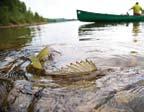






































AUGUST 5, 1907

Rogue Captain Raises British Flag Over U.S. Island.
PORT ARTHUR— In August 1907, front-page headlines filled newspapers across United States with the news that Isle Royale on Lake Superior had been "seized" by Canadians. The Chicago Tribune proclaimed “Gasoline Launch Seizes U.S. Isle: Canadian officer leads band of Patriots on Voyage of Conquest,” while the New York Times headline read “British Flag Up on U.S. Island: Capt. Young Raises It Over Isle Royale He Claims for Canada.”
At various times over the past 300-plus years, three countries had claimed Isle Royale, starting with the French, who named the island in 1671 in honour of King Louis XIV. Later it was British territory, until Benjamin Franklin snagged it for America in the 1793 Treaty of Paris. The island was defined as Chippewa Territory until 1842 when the Ojibwe ceded it to the U.S. federal government. In 1940, Isle

BY ELLE ANDRAWARNER
Royale National Park was established.
for Canada, despite having no actual government authority to do so.
Young told reporters he did it for the “purpose of opening correspondence between Ottawa and Washington,” which he felt would show the “great injustice to Canada by the agreement that gave Isle Royale to United States.”
Finnish-American congressman).
Four years after his armed invasion, Young was elected mayor of Fort William. Later, he became a colonel, served in France during the First World War, and, in 1934, was appointed an Ontario magistrate. He died in 1936 at age 70.

He said the island was north of the 49th parallel (the international boundary) and therefore the island rightfully belonged to Canada.

the New York Times reported, “No further attention will be paid by the State Department to opera bouffe efforts… to involve this country in a diplomatic controversy with Canada.” The Chicago Tribune’s front page proudly declared, “Isle Royale not seized; Old Glory Still Waves,” noting the Canadian “filibusters” had given up. No charges were laid, and while some applauded Young, others laughed at the fiasco, suggesting Young and his group had been “in the cups” (drinking).





Although it is part of Michigan, Isle Royale is less than 20 miles from Canada’s northern shore. Even today, many Canadians don’t hesitate to remark that Isle Royale should be Canadian, not American. But other than quietly grumble, Canadians haven’t taken any action to right this supposed wrong—except in 1907. That’s when a group of armed compatriots, led by Captain Samuel C. Young of the 96th Lake Superior Regiment, left Canada in a “naptha launch,” headed to the northeastern part of Isle Royale, planted a Union Jack there and claimed the island back



Just who was Samuel Crawford Young? He came with some pretty good credentials. A prominent 42-year-old businessman in Fort William (now part of Thunder Bay), Young was a partner in a successful real estate and insurance company. He was one of the city’s greatest promoters, served on numerous boards, founded a golf course, advocated tourism and immigration, and was an optimist known as a “man of both ideas and actions.”





















Within days of Young’s armed run to Isle Royale, the American papers were discounting the incident. On Aug. 6,
About 18 months later, on March 9, 1909, the New York Times reported that “Isle Royale in Lake Superior has just been purchased by American interests from an English syndicate… The largest island in the fresh water in the world has reverted to American ownership through the diplomacy of business and without probably the knowledge of Washington.” The paper noted that IRLC had owned the “entire island” with two small exceptions. The new owner was United States Steel Corporation; its attorney was Duluth’s Oscar Larson (who went on to become America’s first

Perhaps it is a coincidence that at the time Young planted the British flag on Isle Royale, most of the island was owned by a British company, Isle Royale Land Corporation (IRLC). The company had established the mining community Haytown at the foot of Pickett Bay (population 135) and had vigorously, but unsuccessfully, tried to operate the Wendigo Copper Company. In 1892 they ceased mining and began selling its land for tourist homes and resorts. It would be sheer speculation to suggest a connection between real estate titan Young and the British company that owned Isle Royale, but it does give an intriguing twist to an already-strange footnote in Isle Royale history.



“Nobody ever died from eating a few mouse turds”
Mike Kelly was a crookedarmed old man who lived about ten miles from Ely, close to Birch Lake Dam. He was a good friend of my greatgrandfather, Bill La Beau.
Mike fell out of a tree once when a black bear ran him out of a blueberry patch and up a white pine. On the way down, Kelly slipped and fell. He tried to break his fall, and ended up breaking his left arm. It was a long way to town, so rather than going to the doctor, Mike Kelly set the arm himself. It never healed right. That’s how it got crooked.


IRON MIKE HILLMAN
My dad, Chester loved to tag along with his grandfather, Bill La Beau, whenever he went to visit one of his old settler friends –a ragtag assortment of characters who came north and west when the frontier moved to Minnesota. Like many men who grew up with horses, Bill La Beau tried to keep up with the times by buying a Chevrolet

automobile, but he never quite got the hang of it. One day he tried to put the black beast in reverse and ended up going through the front wall of the garage instead.
That ended it for Bill La Beau and automobiles. From then on, whenever Bill La Beau visited any of his old friends, he went with a horse and buggy.
That’s how my father came to have lunch with Mike Kelly. Young Chester Hillman thought it was grand to accompany his grandfather on his visits because the old man let him take hold of the reigns and drive the buggy. It took a long time getting out to Mike Kelly’s shack where Birch Lake empties into the Kawishiwi River. Before they went, Bill La Beau made sure his daughter Cora packed a basket full of jams and sweet preserves for his old friend. Like many of the men living alone in the woods, Mike Kelly


would just about sell his soul for a jar of homemade jelly.
On one of those trips, Mike Kelly insisted they join him for supper. Chester watched as the crooked-armed trapper got down a slab of salt pork greened up with age and sliced off a few slabs. Then the old man boiled up some potatoes about as old as Chester.
As if that weren’t enough, Mike Kelly scooped out some black-flecked flour into an old wooden mixing bowl. Chester gulped, he realizing the black specks were mouse droppings. Mike Kelly smiled as he added water to make a two-inch-thick pancake the old-timers call bannock.
The salt pork was cooked, the potatoes were boiled, and before Chester knew it, his plate was fi lled with one spud, three pieces of green bacon, and a generous wedge of bannock. Just before the three men dived into supper, Mike Kelly limped over to the stove, grabbed the cast-iron skillet, and poured a generous helping of

pork fat over the potatoes and bannock on all three plates.
“You can’t eat until you got some of the gravy, boy,” the old man said with a smile. Chester swallowed hard and ate his supper, every bit of it.
On the way home, he worked up the courage to ask his grandfather if Mike Kelly ate like that all the time.
“Don’t be stupid, boy,” answered Bill La Beau. “Mike Kelly put on his best spread for us. If it was just Mike, he would have had one thing for his supper. Mike gave you a three-course trapper’s lunch in honor of our visit.” He looked over at his grandson and said, “I’m proud of you for eatin g your supper. Lots of boys would have made a fuss about the mouse turds.”
He smiled and added, “Nobody ever died from eating a few mouse turds. They help keep a fellow regular.”


After a day of exploring Thunder Bay’s scenic beauty you’ll appreciate the exceptional amenities of the Valhalla Inn,Northwestern Ontario’s largest premier full service hotel.
From the comforts of our newly renovated rooms and suites to the relaxation of our pool, sauna & spas - you’ll know you’ve made the right choice.
